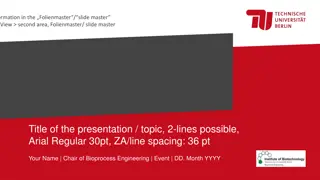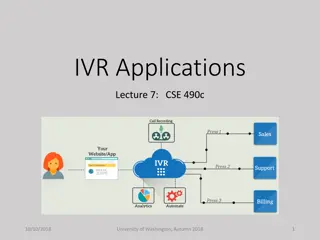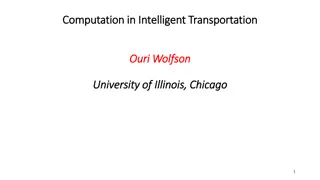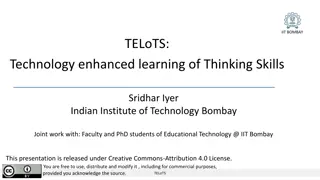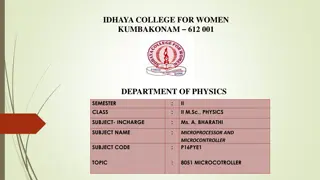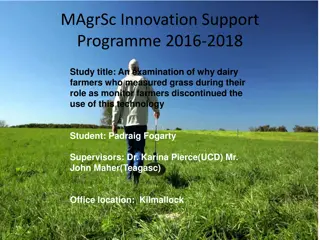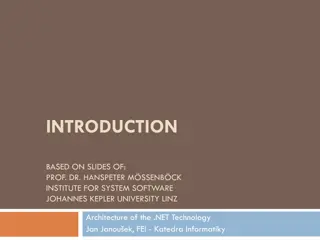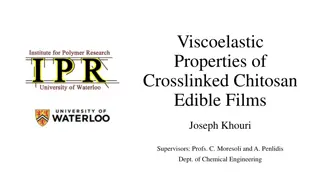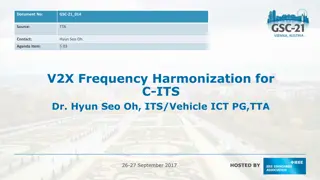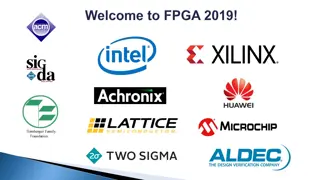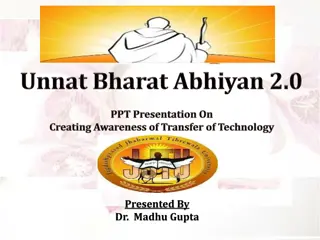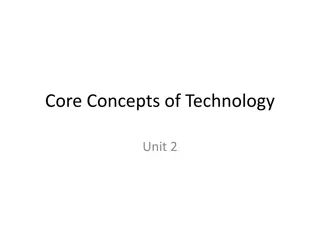Understanding Bioprocess Technology and its Applications
Bioprocess technology involves utilizing living cells or their components like bacteria and enzymes to produce desired products through fermentation. This field covers a range of processes, including microbial bioprocesses, enzyme production, metabolite synthesis, recombinant products, and transformation processes. The development of bioprocess technology has progressed through different stages, each marked by significant advancements. Important components of fermentation technology include drive motors, vessels, instrumentation, and sensors. Screening of industrially important microorganisms is crucial for isolating strains that can produce valuable products. Various techniques like crowded plate method and indicator dye method are used for screening microorganisms.
Download Presentation

Please find below an Image/Link to download the presentation.
The content on the website is provided AS IS for your information and personal use only. It may not be sold, licensed, or shared on other websites without obtaining consent from the author. Download presentation by click this link. If you encounter any issues during the download, it is possible that the publisher has removed the file from their server.
E N D
Presentation Transcript
S.Y.Biotechnology BT 302-Bioprocess Technology PRESENTED BY PRADNYA V. DHIVARE (DEPT. OF BIOTECHNOLOGY)
Introduction to Bioprocess Technology Concept of Bioprocess Technology: Bioprocess is any process that uses complete living cells or their components (e.g., bacteria, enzymes, chloroplast) to obtain desired products. This process is commonly referred to as Fermentation.
Range of Bioprocess Technology There are five major group of commercially important fermentation- 1) Microbial Bioprocess 2) Microbial Enzymes 3) Microbial Metabolites 4) Recombinant Product 5) Transformation process
Chronological Development The Chronological development of Bioprocess Technology may be represented as: Stage 1 - Pre -1900 Stage 2 - 1900 1940 Stage 3 - 1940 to present Stage 4 - 1964 to present Stage 5 - 1979 to present
Basic Principal Component of Fermentation Technology 1) Drive motor , Heaters, Pump etc. 2) Vessels and Accessories 3) Peripheral Equipment (reagent bottle) 4) Instrumentation & Sensor
Screening of Industrially Important Microorganism Primary Screening : Primary screening may be defined as detection and isolation of the desired microorganism based on its qualitative ability to produce the desired product like antibiotic or amino acid or an enzyme etc. In this process desired microorganism is generally isolated from a natural environment like soil, which contains several different species.
The following are some of the important primary screening techniques: (i) The crowded plate technique (ii) Indicator dye technique (iii) Enrichment culture technique (iv) Auxanographic technique (v) Technique of supplementing volatile and organic substrates.
Crowded Plate Method For screening of antibiotic producing organisms, the simplest technique is crowded plate procedure. This technique is used where one is interested only in finding microorganisms that produces an antibiotic irrespective of its action against any specific organism. Hence, the sample is diluted only to such an extent that agar plates prepared from these dilutions will be crowed with individual colonies on agar surface. Colonies producing antimicrobial activity are indicated by clear zone of growth inhibition surrounding the colony.
Secondary Screening In primary screening, we detect and isolate the desired organism but in secondary screening, we characterize industrially important micro-organism which is isolated in primary screening by using highly selective procedures. Here in secondary screening, we screen the organism that is capable of giving the high yield of the product by using the cheap raw material.
Strain Improvement Strain improvement is aTechnology of manipulating & improving microbial strains in order to enhance metabolic capabilities. The directed improvement of product formation or cellular properties through modifications of specific biochemical pathways or by introduction of new pathways using recombinant DNA technology.
Method of Strain Improvement 1) Genetic Recombination or Gene Transfer 2) Mutation 3) Genetic Engineering
Working & Principle of culture collection center Culture collections are centers that provide authentic examples of organisms that can be grown or maintained in the laboratory; they normally have a public service role and can provide associated information and services.
Method of Preservation of culture collection 1) Refrigeration 2) Paraffin Method 3) Cryopreservation 4) Lyophilisation
National centre for culture collection 1) National Collection of Industrial Microorganisms (NCIM) is a national facility and microbial culture repository dedicated to isolation, preservation and distribution of authentic and industrially important microbial strains. Established in 1951, the NCIM is one of the oldest biological resource centers holding especially industrially important microorganisms in the country. Collection holding currently comprises almost 5000 items, including Bacteria, Fungi, Actinomycetes, Yeasts & Algae.
MTCC 2) The Microbial Type Culture Collection and Gene Bank (MTCC) A national facility established in 1986 is funded jointly by the Department of Biotechnology (DBT) and the Council of Scientific and Industrial Research (CSIR), Government of India. The MTCC, housed at the Institute of Microbial Technology (IMTECH), Chandigarh, has established itself as a distinguished culture collection centre for microbial resources in India.


